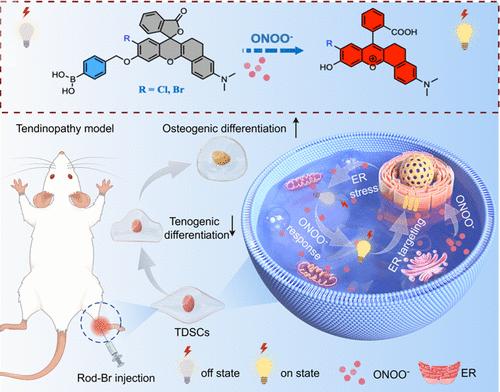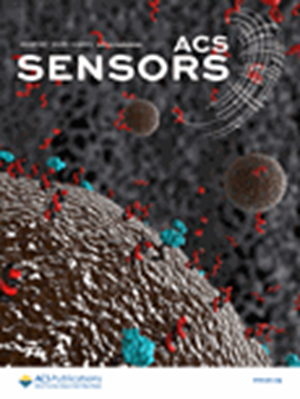Monitoring Endoplasmic Reticulum Peroxynitrite Fluctuations in Primary Tendon-Derived Stem Cells and Insights into Tendinopathy
IF 8.2
1区 化学
Q1 CHEMISTRY, ANALYTICAL
引用次数: 0
Abstract
Tendinopathy is one of the most prevalent musculoskeletal disorders, significantly affecting the quality of life of patients. Treatment outcomes can be improved with an early diagnosis and timely targeted interventions. Increasing evidence indicates that ROS and endoplasmic reticulum (ER) stress play key roles in modulating the differentiation processes of tendon-derived stem cells (TDSCs), thereby contributing to the initiation and progression of tendinopathy. However, the relationship between ONOO– and the differentiation process, as well as the various stages of tendinopathy, remains unexplored. Herein, we developed two highly specific and sensitive fluorescent probes (Rod-Cl and Rod-Br) for detecting ONOO– in the ER. Rod-Br can detect basal levels of ONOO– in the ER of TDSCs and measure ONOO– levels in primary TDSCs stimulated by interleukin-1β over various durations, allowing for comparisons between chondrogenic and osteogenic differentiation and ER stress levels. Additionally, we examined ONOO– variations in different stages of tendinopathy and treatment rat models in vivo and discussed the potential mechanisms. This research provides a robust tool for analyzing ONOO– dynamics in the tenogenic and osteogenic differentiation of TDSCs, offering new insights into the pathophysiology and treatment of tendinopathy.

监测原代肌腱干细胞中内质网过氧亚硝酸盐的波动及对肌腱病的见解
肌腱病是最常见的肌肉骨骼疾病之一,严重影响患者的生活质量。早期诊断和及时的针对性干预可以改善治疗效果。越来越多的证据表明,ROS 和内质网(ER)应激在调节腱源性干细胞(TDSCs)的分化过程中起着关键作用,从而导致腱鞘炎的发生和发展。然而,ONOO-与分化过程以及腱鞘炎各阶段之间的关系仍有待探索。在此,我们开发了两种高度特异和灵敏的荧光探针(Rod-Cl 和 Rod-Br),用于检测 ER 中的 ONOO-。Rod-Br能检测TDSCsER中ONOO-的基础水平,并能测量原代TDSCs在白细胞介素-1β刺激下不同持续时间内的ONOO-水平,从而比较软骨和成骨分化与ER应激水平。此外,我们还研究了ONOO-在体内肌腱病和治疗大鼠模型不同阶段的变化,并讨论了潜在的机制。这项研究为分析 TDSCs 成腱和成骨分化过程中 ONOO- 的动态变化提供了强有力的工具,为腱鞘炎的病理生理学和治疗提供了新的见解。
本文章由计算机程序翻译,如有差异,请以英文原文为准。
求助全文
约1分钟内获得全文
求助全文
来源期刊

ACS Sensors
Chemical Engineering-Bioengineering
CiteScore
14.50
自引率
3.40%
发文量
372
期刊介绍:
ACS Sensors is a peer-reviewed research journal that focuses on the dissemination of new and original knowledge in the field of sensor science, particularly those that selectively sense chemical or biological species or processes. The journal covers a broad range of topics, including but not limited to biosensors, chemical sensors, gas sensors, intracellular sensors, single molecule sensors, cell chips, and microfluidic devices. It aims to publish articles that address conceptual advances in sensing technology applicable to various types of analytes or application papers that report on the use of existing sensing concepts in new ways or for new analytes.
 求助内容:
求助内容: 应助结果提醒方式:
应助结果提醒方式:


